Asset Protection Trusts: Current U.S. Tax Reporting Requirements
Volume XXIII • Number 3 • November – December 2015
INTRODUCTION.
U.S. tax law imposes varied reporting requirements on trusts. The nature of these requirements depends upon whether the trust is a foreign trust or a U.S. trust for U.S. income tax purposes. Note the use of the term “foreign” instead of “offshore” in the preceding sentence. There is no such thing as an “offshore trust” in the Internal Revenue Code – that phrase is a term of art, and it can include a foreign trust or a U.S. trust, depending upon certain factors. The following discussion applies while the grantor (the creator of the trust) is living, and covers the most common filing requirements.
TAX LIABILITY OF TRUST.
No tax will be paid on any of the following discussed tax returns filed by or with respect to the trust while the settlor is living, since the typical asset protection trust will be classified as a “grantor trust” for U.S. income tax purposes. That classification means the grantor will report and pay tax on all tax items reported by the trust.
TRUST INCOME TAX RETURN.
If the trust is a U.S. trust, its income tax return is form 1041, with the “grantor trust” box in the upper left corner checked. If the trust is a foreign trust, its income tax return is form 1040NR, with the “estate or trust” box checked in the upper right corner (in addition, the grantor, if an individual, must annually check the box on Schedule B, Part III, line 8 of Form 1040 to report the foreign trust). 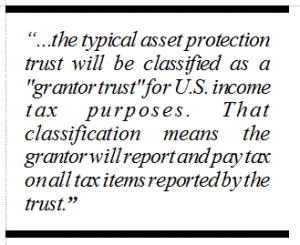
A statement attached to the return id entifies the grantor and sets forth the tax items (interest, dividends, capital gains, etc.) to be reported by the grantor. The tax items reported by the grantor from the trust will also include any such items from any disregarded or “flow-through” entities owned by the trust. The trust’s income tax return is signed by the trustee; form 1041 is due by the 15th day of the 4th month following the close of its tax year – generally April 15th and form 1040NR is generally due by June 15th.
INFORMATION RETURNS.
Two information returns are required for a foreign trust: form 3520 and form 3520-A. These returns are not required for a U.S. trust. Form 3520 (“Annual Return To Report Transactions With Foreign Trusts and Receipt of Certain Foreign Gifts”) is filed by the grantor and is due by the date the grantor’s income tax return is due (including extensions).
Form 3520-A (Annual Information Return of Foreign Trust With a U.S. Owner) is filed by the trustee and is due on March 15th (a 6 month extension can be obtained). It should be noted that FedEx or DHL between the U.S. and most foreign trust jurisdictions is never an overnight process (forget about mail), and that factor must be taken into account in getting Form 3520-A signed by the foreign trustee and returned to the CPA for proper timely filing. Very significant penalties may be imposed for failure to file these information returns.
In addition to the foregoing filings, FinCen form 114 (Report of Foreign Bank and Financial Accounts), commonly referred to as the “FBAR”, must be filed annually to report interests in foreign bank and financial accounts (if the aggregate value of all foreign financial accounts exceeded $10,000 at any time during the calendar year being reported). If the asset protection trust is a foreign trust (and it holds such accounts), the form is only filed by the grantor of the trust; if the trust is a U.S. trust holding such accounts, the form is filed by the trust (we recommend that the grantor also file in this case). This form can only be filed online, and it is due (for 2015) on June 30, 2016. For tax years beginning after 2015, the form is due April 15th (a 6 month extension is available). Finally, taxpayers with specified foreign financial assets that exceed certain thresholds must report those assets to the IRS on Form 8938, Statement of Specified Foreign Financial Assets, which is filed with the filer’s income tax return. Those foreign financial assets could include foreign accounts reported on an FBAR.
CONCLUSION.
We provide all of our asset protection trust clients with a detailed federal tax compliance memo, together with sample forms. In our experience, clients whose CPA’s follow our suggested compliance regime never have an issue with the IRS regarding their trust.
For more than twenty years, AV preeminent attorneys of Donlevy-Rosen & Rosen, P.A. have been leaders in the field of asset protection, authoring books, articles, and research materials for other planning professionals. Contact us to find out how we can better protect your assets.






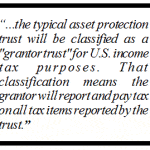


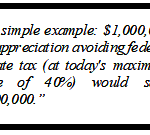
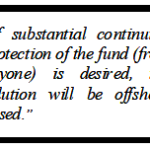




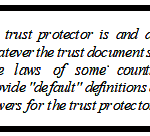



Connect
Connect with us on the following social media platforms.